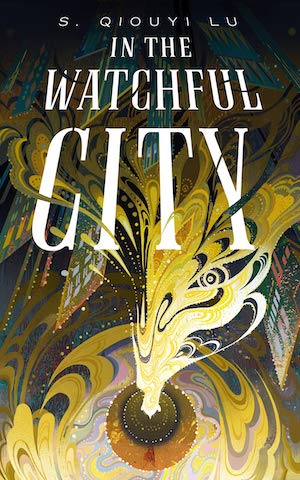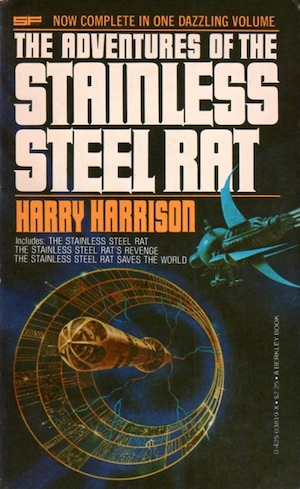In this bi-weekly series reviewing classic science fiction and fantasy books, Alan Brown looks at the front lines and frontiers of the field; books about soldiers and spacers, scientists and engineers, explorers and adventurers. Stories full of what Shakespeare used to refer to as “alarums and excursions”: battles, chases, clashes, and the stuff of excitement.
I have long been a fan of author Harry Harrison, and among his most popular works is the tongue-in-cheek series that follows the adventures of con man and thief James Bolivar “Slippery Jim” DiGriz, also known as “The Stainless Steel Rat.” Today, we’ll look at the first published adventure of that colorful character.
I have read a lot of Harry Harrison’s work over the years, and have vague impressions of reading some of the adventures of Jim DiGriz. But the adventures I remember are shorter stories, which I probably read in Astounding, or some other magazine or collection. There were many other novels I could have also read, so this re-read was an effort on my part to solve a mystery. Why, when I was predisposed to read work by Harry Harrison, did I not continue reading the adventures of the Stainless Steel Rat after the first few exposures?
After all, there were plenty of Stainless Steel Rat books to choose from, as Harrison continued the series until the end of his career. The first three books, The Stainless Steel Rat (1961), The Stainless Steel Rat’s Revenge (1970), and The Stainless Steel Rat Saves the World (1972), appeared in chronological order. They were then collected into an omnibus, The Adventures of the Stainless Steel Rat (1978), which was released during the same year as the fourth book of the series, The Stainless Steel Rat Wants You (1978). Harrison then produced some prequels that featured DiGriz’s early adventures, The Stainless Steel Rat is Born (1985), and The Stainless Steel Rat Gets Drafted (1987). The next book was a collection of short works apparently intended to cap off the series, The Golden Years of the Stainless Steel Rat (1993). But then another prequel book appeared, The Stainless Steel Rat Sings the Blues (1994). And after that, there were three more books set between the other adventures and the “Golden Years” collection; The Stainless Steel Rat Goes to Hell (1996), The Stainless Steel Rat Joins the Circus (1999), and The Stainless Steel Rat Returns (2010).
Along the way, Slippery Jim runs cons, steals, helps the authorities, foils revolts, travels in time, foments revolts, gets married, has kids, runs for office, and thwarts invasions, just to mention a few of the events in his exceedingly eventful life. His adventures also appeared in comic books, choose-your-own adventure books, and board and video games.
About the Author
Harry Harrison (1925-2012) was a popular science fiction author whose career began in the 1950s and lasted for many decades thereafter. I’ve looked at Harrison’s work before in this column, including his classic satire Bill, The Galactic Hero (which I reviewed here), and the novel Deathworld (which I reviewed here), and you can find more information on Harrison and his long and illustrious career in those reviews. Another Harrison book worth mentioning is A Transatlantic Tunnel, Hurrah!, which was steampunk before the term steampunk had even been invented. Harrison frequently wore his heart on his sleeve in his writing, and he was liberal in his politics, anti-war, and—as a result of his experiences during military service—distrustful of bureaucracies and authority in general.
As with many authors who were writing in the early 20th Century, a number of works by Harrison can be found on Project Gutenberg.
Criminals of the Future
Stories are driven by conflict and competition, and there is perhaps no more enduring conflict in human society than that between criminals and law enforcement. Entire literary genres are built on this conflict.
It is thus no surprise that cops and criminals have been part of science fiction since its inception. When I look back on reviews I have written for this Front Lines and Frontiers column, a large number of them feature some sort of plot or subplot that centers on crime. For example, E. E. “Doc” Smith’s famous Lensman series, while often thought of as military science fiction, also features a continuing conflict between the Galactic Patrol and the “zwilniks,” or drug runners. Edmund Hamilton’s Captain Future was deputized by the solar system’s Planet Police. H. Beam Piper’s stories often featured pirates, criminals, and police, including time police who keep order in alternate timelines. James H. Schmitz frequently wrote stories that pitted government agents against thieves and murderers. The always useful Science Fiction Encyclopedia has an excellent and comprehensive article on the theme of Crime and Punishment in science fiction, which you can find here.
Slippery Jim DiGriz also stands as a good example of a fictional antihero, a protagonist with a mix of admirable and undesirable behaviors. I recently discussed the topic of antiheroes in my review of Damnation Alley by Roger Zelazny (and you can find that discussion here).
The Stainless Steel Rat
This reading really gave me a chance to see what I liked about the stories and character, what rubbed me the wrong way the first time around, and what dates the story now. It is obvious to me why the stories were so popular. Harrison’s style is breezy and entertaining, and he keeps his tongue firmly in cheek throughout. The title character is a rogue, but while he wasn’t likeable to me, I can see why he appealed to others. And there are lots of surprises and puzzles along the way to keep the readers engaged.
Like many older science fiction books, this first book in the series is a “fix-up,” with the chapters of the book having appeared in shorter form, and the story then expanded to novel length. The universe is a fairly generic science fiction future, with humans having spread to the stars, and space travel by faster-than-light drive being roughly the equivalent to travel between continents on our world. There had been some sort of setback for human civilization, and the interstellar government is somewhat loosely organized. Other than planetary governments, the main threat to a conman like DiGriz is the Special Corps, a law enforcement agency consisting of reformed criminals (based on the old saying that it takes a thief to catch a thief). Crime has been almost completely eliminated through advanced psychology and brain surgery. Some of the technology portrayed is horribly dated: Information technology consists of lots of paper and massive computers using punch cards. The monetary system still centers on coins and paper bills. So many of the techniques DiGriz uses in his cons simply would not work in our current society, which takes some of the fun out of things.
Buy the Book


In the Watchful City
The book opens with the police having discovered an operation where DiGriz was stealing, relabeling, and selling material removed by robots from a government warehouse. So he drops a safe on the police officer at the door. Then, after horrifying the reader, Harrison lets us know that it was a robot police officer. This is far from the only time Harrison does the literary version of a bait and switch for shock value or as a joke. And right from the start, I found a reason to dislike the Stainless Steel Rat. You see, I’ve been a rule follower from a young age, and grew up to join the Coast Guard and become a Federal law enforcement officer. So even as a young reader, and even though Harrison makes it clear DiGriz is an ethical thief who does not take lives, I did not care for the character’s profession.
DiGriz tries to pull another con, only to fall into the clutches of the Special Corps. But instead of going on trial, he is called in by the director, Harold Peters Inskipp, a former criminal himself, for a job interview. An old literary trick to make readers empathize with a criminal protagonist is to either pit them against a worse criminal or have them work for the authorities, and it looks like this might be where the narrative might be going, at this point. But nothing moves in a straight line for the Stainless Steel Rat.
The Special Corps puts DiGriz into training, and during his research, he discovers an effort to build a battleship in secret, by calling it a cargo ship, and then adding the military features at the last minute by change orders. So Inskipp puts a naval vessel at his disposal, and sends him to investigate. A conversation between DiGriz and the commanding officer encapsulates another of the things I didn’t like about the Stainless Steel Rat:
“Modest, aren’t you,” [the commanding officer] said.
“I try not to be,” [DiGriz] told him. “False modesty is the refuge of the incompetent.”
I had been taught from birth to be modest, and was exceptionally good at it. DiGriz is definitely the opposite of modest, and the first-person narration makes that impossible to ignore.
DiGriz arrives on the planet where the battleship is being built and finds that the mastermind has a female accomplice assisting him. In a nick of time, and to make a long story short, DiGriz is able to capture the battleship, and the criminals, only to have the woman escape. And here is one of the biggest twists in the book. It turns out the man is the accomplice, and the woman is the real mastermind! DUHN, DUHN, DUHN! Obviously, what might have seemed radical in the sexist days of the past doesn’t surprise a modern reader, so this twist falls flat here in 2021.
The criminal, Angelina, has no compunction about murder, and leaves a trail of bodies in her wake. DiGriz is frustrated that he has been outconned, and decides to capture Angelina, becoming so obsessed in his quest that he runs afoul of his superiors in the Special Corps. But the more he pursues her, the more he is confused about his motivations. His admiration for this woman’s abilities as a con artist is growing, as is his physical attraction to her. Is he pursuing her for the Special Corps, or for himself? This whole sub-plot disturbed me as a youth, and it does to this day. Even in a society where brain surgery can remove homicidal tendencies, I can’t ever see a serial killer being the object of anyone’s affection.
Final Thoughts
If you like morally ambiguous characters and love a good caper with a lot of twists and turns, and no small amount of humor, then The Stainless Steel Rat is for you. While it was not to my taste, I can see why people enjoy the series. Myself, I could not get past the criminal behavior as a young reader, and I have trouble with the sexism today.
And now I’d like to hear your thoughts. If you’ve read The Stainless Steel Rat, or the other tales following the adventures of Slippery Jim DiGriz, what did you think of them? Are you like me, and not too keen on the stories, or are you a fan?
Alan Brown has been a science fiction fan for over five decades, especially fiction that deals with science, military matters, exploration and adventure.










